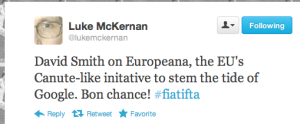Luke McKernan, Curator for Moving Images at the British Library posted this amusing tweet at a conference last year.
Aided by the pithiness of Twitter, Luke likened the doomed attempt of the Danish king Canute to hold back the sea to Europeana’s attempts to provide a European, culturally aware alternative to a Google.
In one sense, Luke’s comment hits the mark. Given Google’s accumulation of expertise, massive stores of data and sheer financial muscle, it will always be difficult for Europeana to match Google’s core strength – that of providing a search engine that points users to the stuff they want to find.
And while Europeana can point to a ‘long tail’ of aggregated content, some of Google’s spin off projects (such as Google Art Project or the Google Cultural Institute) achieve an instant user traction that Europeana will find difficult to match.
But focussing just on the portal misses where Europeana can really have an effect on Europe’s digital cultural heritage.
Rather a fantastic strength of Europeana is its ability to advocate the necessary changes that allow digitised content from Europeana cultural heritage institutions to be opened up for the widest possible range of uses and users.
Europeana is not just about the Europeana web portal but the continent’s astonishing network of libraries, museums, archives and other collections; all institutions that are dealing with the challenges faced by digitising and publishing collections in the age of the Internet.
Clear licencing terms; high-quality openly available metadata; a strategic approach to user access to materials (often, but not necessarily always, open access); use of open standards; use of addressable URIs for digital items – these are all essential ingredients for deriving the maximum richness from Europe’s online cultural heritage.
Europeana has a key role of helping create and put forward the winning arguments that persuade institutions to adopt these best practices.
There is still much to do – 64% or items do not come with clear licencing terms (ppt, slide2); and about 3% (c. 660,000 digital objects) have broken links. But, for example, the work done by the Rijksmuseum in the Netherlands, the Statens Museum for Kunst in Denmark, the British Library’s medieval manuscript department, and indeed the exposure of Europeana’s own dataset of 22m metadata records, demonstrate that some institutions are making significant decisions about sharing their content online.
A tide is definitely turning.

Leave a comment